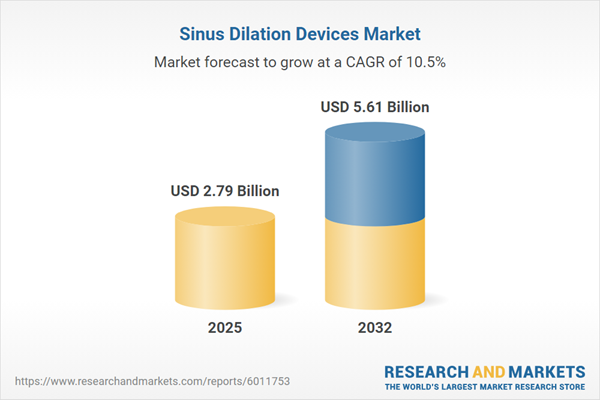Speak directly to the analyst to clarify any post sales queries you may have.
Sinus dilation devices are transforming patient care pathways in otolaryngology by enabling less invasive, highly precise interventions. Senior healthcare leaders evaluating this market need actionable intelligence to address changing clinical protocols, evolving procurement expectations, and intensified regulatory oversight.
Market Snapshot: Sinus Dilation Devices Market Growth and Outlook
The global sinus dilation devices market is advancing with a steady growth trajectory, currently valued at USD 2.53 billion in 2024. Projections indicate further increases to USD 2.79 billion by 2025 and a long-range outlook of USD 5.61 billion by 2032. Expansion is propelled by rising demand for minimally invasive procedures, ongoing product innovation, and greater regulatory engagement across both mature and emerging markets. Healthcare providers, device distributors, and manufacturers are proactively streamlining product portfolios, adopting advanced procedural technologies, and refining procurement approaches to remain aligned with shifting clinical and operational needs.
Scope & Segmentation of the Sinus Dilation Devices Market
This executive report offers structured analysis across mission-critical dimensions. Each segment supports strategic planning and risk management for decision-makers seeking clarity in a dynamic environment:
- Technology: Balloon dilation systems, navigation-enabled devices, conventional procedural solutions, and ostial stents—including bioabsorbable, drug-eluting, and non-absorbable types—equip institutions to evaluate system integration and enhance procedural capabilities.
- Product Type: Reusable and single-use device formats drive informed procurement, balancing cost efficiency, compliance, and supply chain continuity in diverse care settings.
- End User: Clinics, ambulatory care centers, specialty facilities, community healthcare providers, and hospitals—each environment presents distinct purchasing dynamics, influencing workflow and delivery models.
- Procedure Type: Office-based interventions under local anesthesia as well as complex in-hospital procedures guide workforce allocation, training, and care delivery transformations.
- Distribution Channel: Direct, indirect, and retail distribution mechanisms inform agile supply strategies and facilitate responsive market access approaches.
- Indication: Devices for both acute and chronic sinusitis—with or without nasal polyps—enable matching of products with specific clinical protocols and targeted patient populations.
- Regional Coverage: Comprehensive analysis spans the Americas, Europe, Middle East, Africa, and Asia-Pacific, with focus on regulatory and operational environments in markets such as the United States, Canada, Mexico, China, India, Japan, and Australia.
- Company Coverage: Performance and market positioning are benchmarked for major players including Medtronic plc, Acclarent Inc., Stryker Corporation, Smith & Nephew plc, and Olympus Corporation to guide competitive and partnership strategies.
Sinus Dilation Devices Market: Key Takeaways
- Advanced visualization and navigation solutions drive clinical standardization, fostering more consistent and safer outcomes for sinus interventions.
- Growth of office-based sinus procedures is prompting realignment of operational resources, increasing flexibility in staff deployment and patient management.
- Regionalized sourcing and adaptive supplier partnerships are enhancing supply reliability and helping organizations meet increasingly complex regulatory demands.
- Digital transformation strategies, such as remote training and integration of smart devices, are accelerating the adoption of emerging procedural technologies and supporting robust, end-to-end care delivery.
- Procurement models are evolving to prioritize supply chain resilience and to accommodate shifting reimbursement dynamics and regulatory compliance frameworks.
Tariff Impact on Sinus Dilation Device Supply Chains and Market Access
Changes in United States tariff regulations are prompting manufacturers to reassess cost frameworks and procurement models. Senior decision-makers are focusing on optimizing supplier networks, evaluating production sites, and adjusting sourcing strategies to sustain supply continuity and align with new industry requirements.
Methodology & Data Sources
This assessment integrates interviews with healthcare professionals, procurement leads, and hospital administrators. All market findings are substantiated through technical literature review, regulatory documentation, and validation by subject matter experts to ensure data reliability for executive planning.
Why This Report Matters
- Presents actionable segmentation and market intelligence to enable investment alignment and effective strategy design for leadership teams in the sinus dilation devices sector.
- Supports accurate market forecasting and prompt responses to regulatory shifts and operational imperatives through in-depth technological, regional, and distribution channel insights.
- Facilitates streamlined adoption of new sinus dilation technologies by aligning procurement with current and future healthcare delivery models.
Conclusion
This report provides senior executives with validated insights to inform strategic planning and operational agility in the evolving global sinus dilation devices market. Leaders are empowered to align corporate initiatives with organizational objectives and enhance market competitiveness.
Additional Product Information:
- Purchase of this report includes 1 year online access with quarterly updates.
- This report can be updated on request. Please contact our Customer Experience team using the Ask a Question widget on our website.
Table of Contents
3. Executive Summary
4. Market Overview
7. Cumulative Impact of Artificial Intelligence 2025
Companies Mentioned
The companies profiled in this Sinus Dilation Devices market report include:- Medtronic plc
- Acclarent, Inc.
- Stryker Corporation
- Smith & Nephew plc
- Olympus Corporation
- KARL STORZ SE & Co. KG
- Spirox, Inc.
- SinuSys Corporation
Table Information
| Report Attribute | Details |
|---|---|
| No. of Pages | 191 |
| Published | October 2025 |
| Forecast Period | 2025 - 2032 |
| Estimated Market Value ( USD | $ 2.79 Billion |
| Forecasted Market Value ( USD | $ 5.61 Billion |
| Compound Annual Growth Rate | 10.4% |
| Regions Covered | Global |
| No. of Companies Mentioned | 9 |









